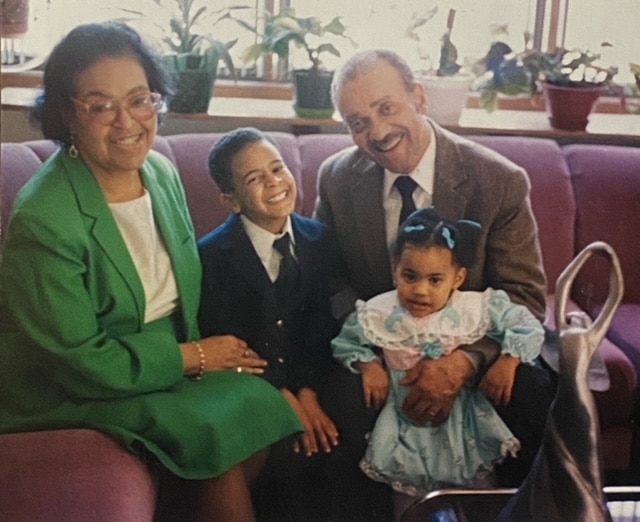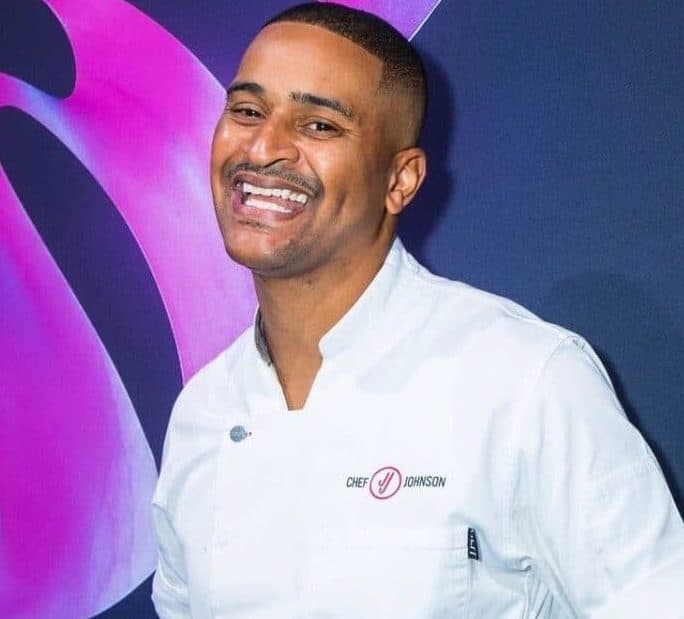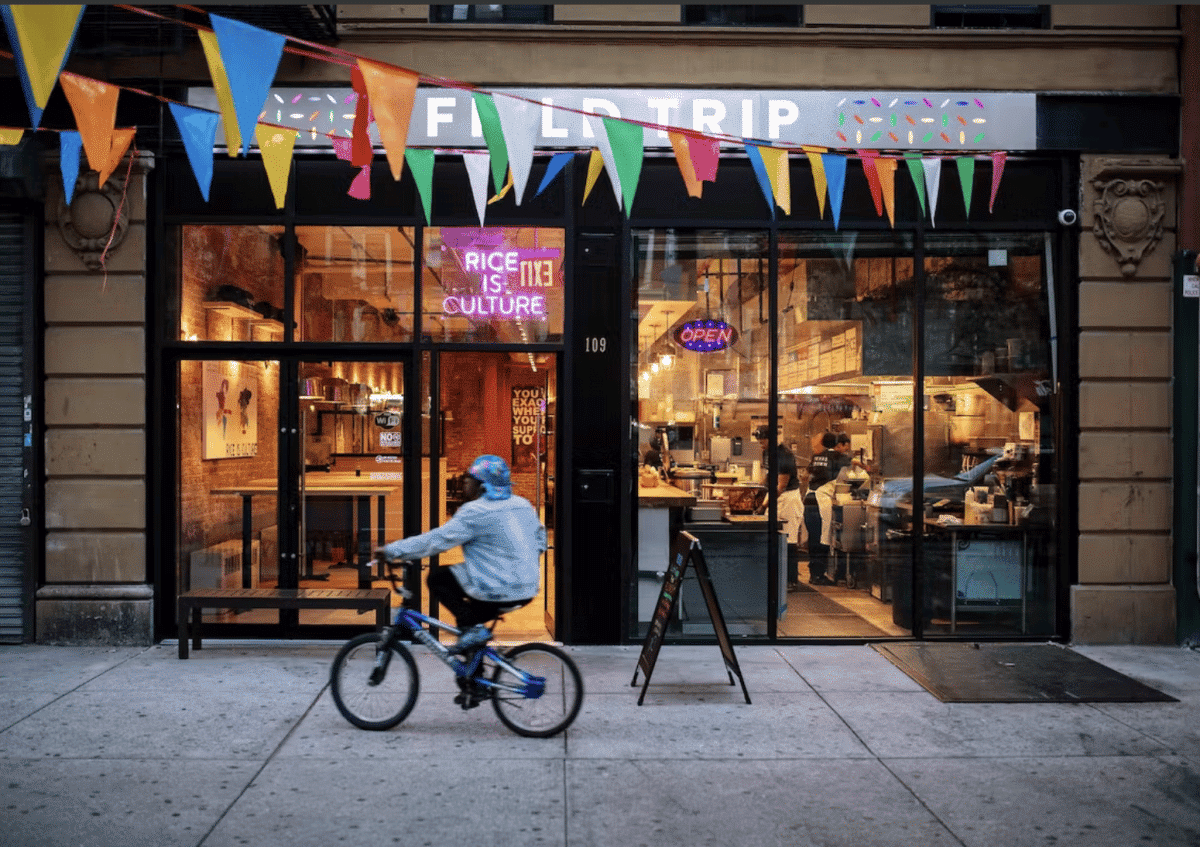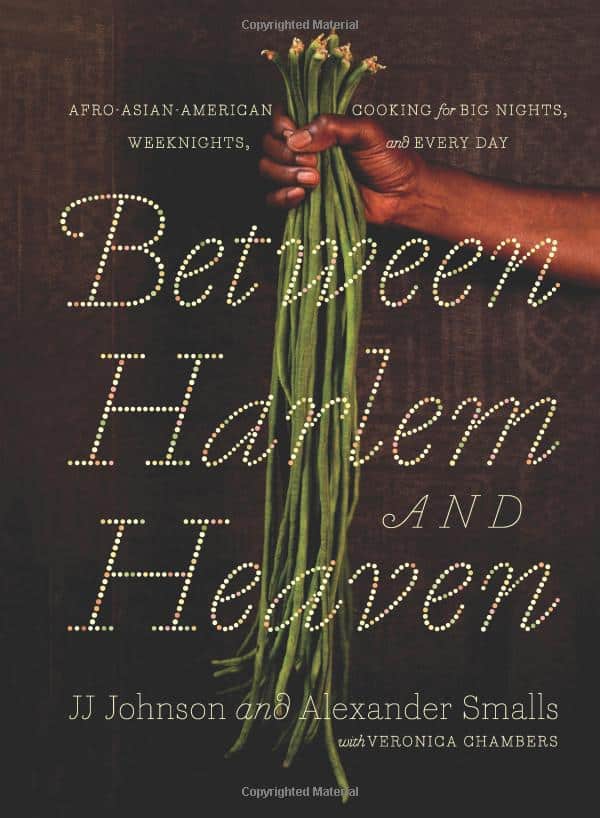I’m Chef JJ Johnson, founder of FIELDTRIP in New York City, and James Beard Award winner.
To be honest, it feels weird to say all that to introduce myself. My restaurant is a quick-casual rice bowl shop located in Harlem that highlights rice traditions from around the world. From Caribbean to Asian to African, I try to represent each cuisine as best I can.
My cookbook Between Harlem and Heaven: Afro-Asian-American Cooking for Big Nights, Weeknights, and Every Day does the same. It’s not a “fusion cuisine” book, but a tribute to the influence that the African diaspora had on cuisine overall. As a chef, I want to put a spotlight on my culture and its influence. My next cookbook, The Simple Art of Rice: Recipes from Around the World for the Heart of Your Table comes out next year. It honors my Caribbean and Southern background as well as the places I’ve been to. I have traveled to Israel, Singapore, Anguilla, Bermuda and have studied in India and Ghana. Though rice is such a big part of everyone’s culture globally, it doesn’t get the love it deserves in the United States.
The education of a chef
I started this journey when I began cooking with my grandmother. She was Puerto Rican and my grandfather was from Barbados, so it was a very Caribbean home, especially when it came to food. For breakfast my grandmother liked asopao, a soupy Puerto Rican rice dish that she ate from a coffee cup. I loved her paella that she made in a big cast-iron skillet. She had an electric ice cream machine, and was a devotee of Julia Child, the Galloping Gourmet, and Martha Stewart.
My grandmother made me feel included in the kitchen, not too young to help or cook. I saw how she could bring family and friends together through meals served at her big table. That’s exactly what I want to do–bring people together.
I never paid much attention to the knives. My uncle Donald, who owned and operated a crab boat and was an excellent cook, often complained about my grandmother’s dull knives. I genuinely believed that “sharp” was the only requirement for a good knife.

When I left our family home in the Poconos mountains, Pennsylvania, for school at the Culinary Institute of America, I showed up unprepared. I didn’t bring even a single knife with me. I brought only my dopest sneakers and vibes. My roommate arrived with a toolbox and a large knife set. We were still kids, but he had German, Italian and Japanese knives with him. Safe to say, he was taking this more seriously than I was. I recall asking him why. “Doesn’t the school provide us with knives?” Even when I found out that the school-issued knives weren’t as sharp as his, I still didn’t think it mattered much. I didn’t think that the knives you used were super important or a big deal.
An education in knives
The first knife I purchased was a 10-inch German knife. Sharp, and so balanced I could hold it on my middle finger and show off while saying: “Look how balanced this is!” However, I soon realized that it wasn’t the right knife for me. It was uncomfortable, it was heavy, it did just that one cool trick. Going for the “cool” knife didn’t work. I hadn’t understood the value of actually researching and trying out knives. I had been treating knife selection like I treated shopping for sneakers. Buying the shiniest, coolest looking knife, not the one that would actually work for me.
My culinary internship was at Tribeca Grill, an insane place with the heartbeat of New York City. The restaurant served 800-1100 meals in an evening. I was assigned to work garde-manger, preparing cold foods. You need to have amazing knife skills to work this, and to this day I am not sure why I was chosen for this station. My knife skills weren’t great at all and I didn’t have a knife to help me improve them. I now know that in a niche career our most important tool is an accessory that defines us. A barber with clippers; a writer and a favorite pen. Chefs and their knives. I still hadn’t found that defining tool to represent me.
The “Air Jordans” of knives
The knives I’d acquired were still not sharp enough to please my uncle, and they never felt right in my hand either. They were too heavy, too unwieldy. Jared, a line-cook at Tribeca Grill, introduced me to the world of knife selection.
My grandmother made me feel included in the kitchen, not too young to help or cook. I saw how she could bring family and friends together through meals served at her big table. That’s exactly what I want to do–bring people together. I liked her glass spice rack, her dark wood knife block, the aroma of her food, and her loud Caribbean music. I never paid much attention to the knives. My uncle Donald, who owned and operated a crab boat and was an excellent cook, often complained about my grandmother’s dull knives. I genuinely believed that “sharp” was the only requirement for a good knife.
Before my decision to study Culinary Arts, I had seriously considered coaching basketball. Coaching sports and working in a kitchen are both all about teamwork. I accepted his invitation to go knife shopping at a store that specializes in professional quality Japanese knives, tableware, kitchen appliances, kitchen tools, and barware. Honestly, the store reminded me of a high-end sneaker store, with knives that were stacked and displayed beautifully. Hand-crafted, glistening tools with polished wood handles in a variety of colors, calling to me. This was the moment to find a knife that would feel like discovering my first pair of Jordans.
I was impressed. I watched Jared spend his whole paycheck on two knives. I needed to fall in love with only one, to fit my budget. A reasonable knife can cost between $50 and $300. Just one knife, not a set. It is so worth it, though, because good knives can last a lifetime and make cooking easier and more pleasurable. When shopping for a knife, you are looking for balance, weight of the knife, and how it fits in your hand. I always choke up on the handle to ensure I have a good grip on it.

I was impressed. I watched Jared spend his whole paycheck on two knives. I needed to fall in love with only one, to fit my budget. A reasonable knife can cost between $50 and $300. Just one knife, not a set. It is so worth it, though, because good knives can last a lifetime and make cooking easier and more pleasurable. When shopping for a knife, you are looking for balance, weight of the knife, and how it fits in your hand. I always choke up on the handle to ensure I have a good grip on it.
When buying a knife, how you are going to use it matters. When considering the length of the blade, 6-8 inch works for smaller, and 8-10 inch for larger hands. Small paring knives make it easy to peel fruits and vegetables, core tomatoes, hull strawberries, and do any type of knife work that takes precision. Most chefs own several.
I was impressed. I watched Jared spend his whole paycheck on two knives. I needed to fall in love with only one, to fit my budget. A reasonable knife can cost between $50 and $300. Just one knife, not a set. It is so worth it, though, because good knives can last a lifetime and make cooking easier and more pleasurable. When shopping for a knife, you are looking for balance, weight of the knife, and how it fits in your hand. I always choke up on the handle to ensure I have a good grip on it.
I decided on a Shun 8-inch chef’s knife. The shape called a “chef’s knife” is long and triangular, good for a beginning cook because its versatility helps a cook to master a range of skills. The wide blade keeps knuckles off the cutting board and helps you move food from the cutting board to your pan. It is great for mincing herbs. It sat nicely in my hand. It was light and felt like I was holding nothing, so it is less tiring than the European knife I was used to. I joyfully made the investment and purchased my first Japanese knife.
I was impressed. I watched Jared spend his whole paycheck on two knives. I needed to fall in love with only one, to fit my budget. A reasonable knife can cost between $50 and $300. Just one knife, not a set. It is so worth it, though, because good knives can last a lifetime and make cooking easier and more pleasurable. When shopping for a knife, you are looking for balance, weight of the knife, and how it fits in your hand. I always choke up on the handle to ensure I have a good grip on it.
Now, of course, I own a wide array of knives and I love them all. I think most of my peers would agree that Japanese knives are top tier in the culinary world. They’re lighter than other knives, have thinner blades and strong steel, and are perfect for precise cuts. I believe that everyone should own at least one “chef’s knife” that can do it all, such as the kiritsuke. It is great for prep service, can be used with meat and is especially good for cleaning fish. Great for veggies and fruits too. A good paring knife is also key for smaller tasks and cutting. It is essential for decorative plating purposes. A lightweight santoku knife is ideal if you’re going for hours. In the holiday I know I’ll be prepping, cutting for meals all day.
Knives as Common Ground
Chefs are interested in each other’s knives. It forges connections. The chef’s knife is one of the most important tools for a chef or home cook. You need to keep it sharp, take care of it and protect it. It helps you, guides you and lifts you. It can put a smile on your face. It’s so satisfying when you cut clean through vegetables, break down chicken, or slice a piece of duck. That’s what it does for me today, it makes the job I love even better. ![]()
I was impressed. I watched Jared spend his whole paycheck on two knives. I needed to fall in love with only one, to fit my budget. A reasonable knife can cost between $50 and $300. Just one knife, not a set. It is so worth it, though, because good knives can last a lifetime and make cooking easier and more pleasurable. When shopping for a knife, you are looking for balance, weight of the knife, and how it fits in your hand. I always choke up on the handle to ensure I have a good grip on it.
In Partnership with ShunKai.USA

“A barber with clippers; a writer and a favorite pen; a chef and a knife. A chef’s knife is more than a tool, it’s an identity.”
Good knives can last a lifetime and make cooking easier and more pleasurable.

